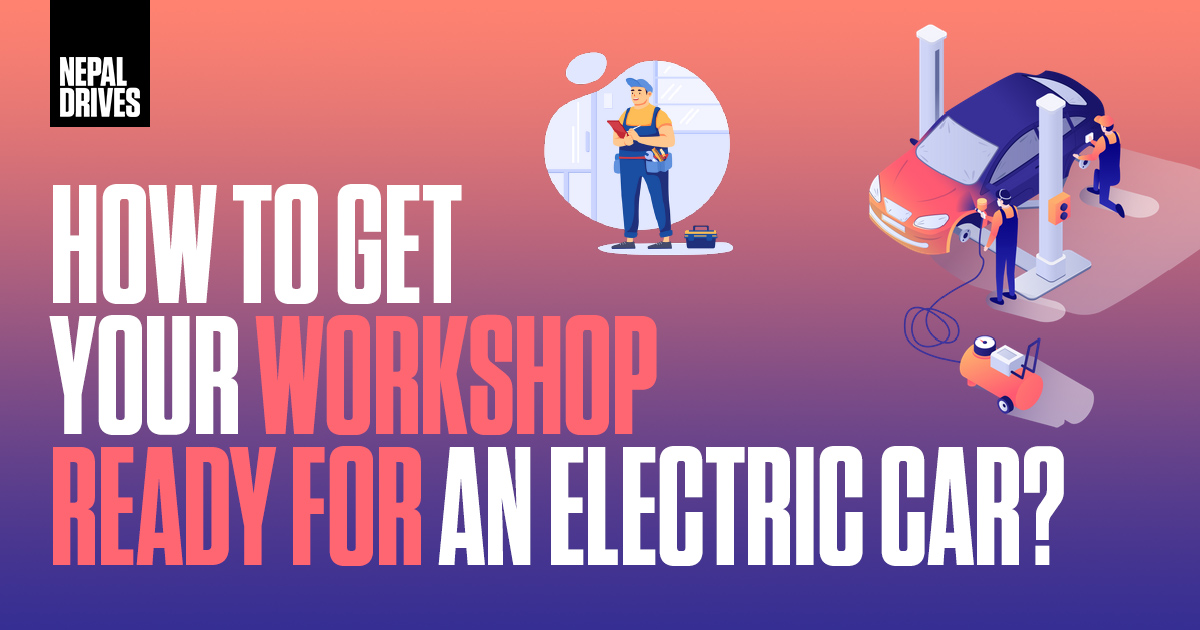Nepal Government has announced that the sale of all new petrol and diesel vehicles will be banned from 2030. This drastically changes things for existing garages, workshops and service centers and the equipment they will need to cater to the vehicles of the future.
Electric cars are still relatively new, but they are growing in popularity due to their eco-friendly benefits and the simple fact that they don’t require gas. Instead, electric cars need to be charged in order to run.
While engineer training will be essential and investing in knowledge paramount, the garage equipment needed to service and care for the new generation of electric vehicles is an investment we can’t ignore. Investing now, embracing the new electric trend, is a fantastic opportunity. Being able to service electric vehicles in the current political and social climate sets any independent garage, service center, or auto workshop apart and is an obvious magnet for work and an investment for the future. What, however, do we need and what’s the difference in the workshop design of today?
1)Installation of plugs and specialist sockets: Put a sufficient number of plugs and sockets with 32amp Commando Sockets as standard. It’s simple future-proofing ready for the immediate or future installation of EV charging points.
2) Workshop lifting equipment: Right now, electric vehicles are likely to weigh around 20-30% more than their fossil fuel counterparts, mostly due to the weight of their batteries. This, combined with the necessary under-car access for battery removal, means a new generation of specifications is required for lifting equipment. Many manufacturers have already released specific requirements and specifications for minimum access and weight distribution, specifically for their new electric vehicles and their maintenance. Space around the lift and safety access is more important than ever.
3) Installation of fire hazardous equipment: Current electric vehicles operate at up to 650 volts (DC). Any DC voltage above 150 volts is considered hazardous to the mechanics and engineers working on the vehicles and 650+ volts is likely to be fatal. Therefore, a large part of the modern EV workshop is insulation, and in case of fire or discharge, immediate access is critical to remove the vehicle from the workshop. This may be, out of necessity, by fire safety professionals or by EV mechanics. Workshops have the very real dangers of stored electrical energy and explosive gasses to deal with, with the potential to cause fire or an explosion.
4) Specialist Wheel Alignment: Wheel alignment will be essential in the future. Correct wheel alignment promotes range and efficiency, and this will be a big customer draw in the years to come. Getting a customer an extra ten km per charge is the new fuel-efficiency tuning in the roads of Kathmandu. Accuracy and repeatability will be key factors. An offering wheel alignment will be key in securing EV business.
5) High Voltage Tools and Equipment:The electrical industry has specific standards for test equipment that is to be used in a high voltage environment. A minimum of CAT III 600v or CAT IV 1000v is required to ensure the test tools are suitable and safe for working on high voltage systems. Hand tools are required to be fully tested and insulated to IEC 60900:2012 standards, and carry the international symbols for High Voltage Tools. Typical tools required will include socket sets, wrenches, screwdrivers, and torque tools although most vehicle manufacturers will only use a limited selection of sizes of each. Everything is about ensuring the safety of technicians, employees, and customers.
6)Battery Lifting Tables: A key addition to a workshop with an Electric Vehicle Bay will be a lifting table. Battery maintenance is a key part of the service of an electric vehicle since the battery is the largest and most expensive single component. A robust lift table for battery management will be required. There are a number of them on the market ranging significantly in price depending upon whether you want a manual operation, electric operation, your capacity requirements, lift speed and lifting height considerations, considerations as well as key Health and Safety considerations.
7) Train Your Technician: Repairing electric vehicles is nothing that should cause you concern, as long as you know what you need to know. But technology in electric vehicles may change rapidly so shop operators need to stay up-to-date on new technology. It would be very dangerous to assume that, just because you’ve worked on one type of Electric or Hybrid vehicle, you’ll use the same procedure for all types of electric vehicles. Electric vehicles are a diverse lot: there are pure electric, extended-range electric, or gas and electric hybrid. Repair procedures could be different for all of them.
Fortunately, there aren’t too many big, expensive pieces of equipment you need to buy. “The biggest investment the industry needs to make when it comes to hybrid and electric cars is training, education, and information”.
8) Prepare for Roadside Assistance & Vehicle Towing Service: Some situations where customers may need roadside assistance service to get their electric vehicle back on the road.
- Dead battery
- Brake related problems
- Accidental
- Flat Tyre
- Minor Repair
- Electrical failure
Providing roadside or towing service to electric vehicles requires sophisticated technology. Most people think that towing is an industry that uses outdated technology to deliver its services. In Nepal, some of the top towing companies use advanced technology to provide faster and cheaper roadside services.
As a reputable towing company in Nepal, Towing Nepal takes technology as an opportunity to grow quickly and improve public safety. No matter the model or technology of your vehicle, they are prepared to provide prompt roadside assistance as well as towing services. From providing long-distance towing to fixing minor mechanical problems, they provide comprehensive services making your life easier.Disclaimer: The views and opinions expressed in this article are those of the writer and do not necessarily reflect the views or positions of Nepal Drives.











